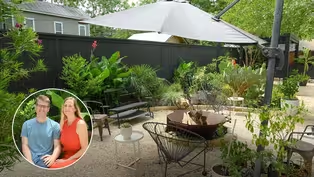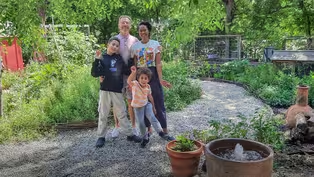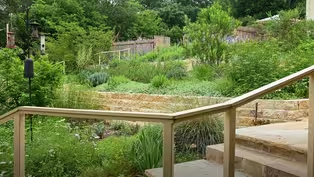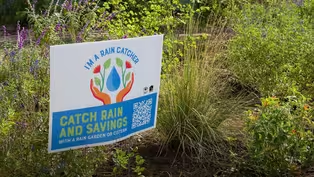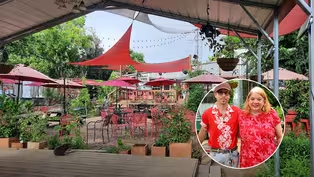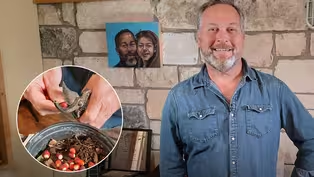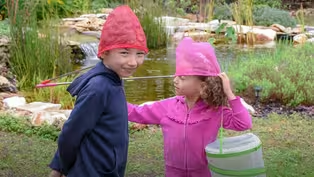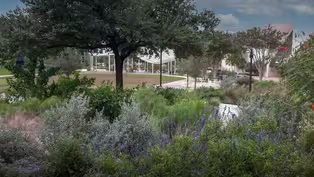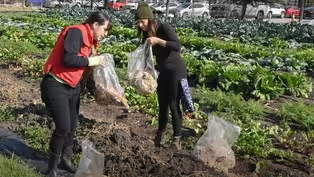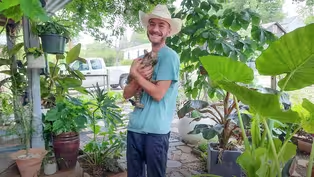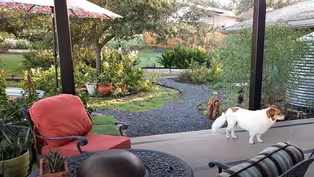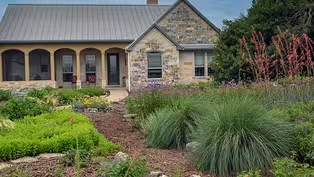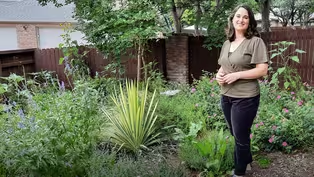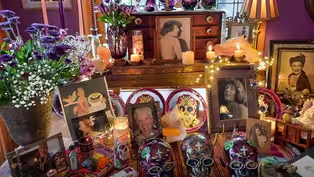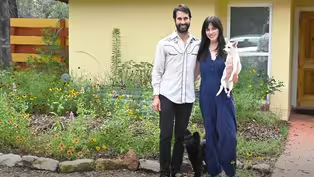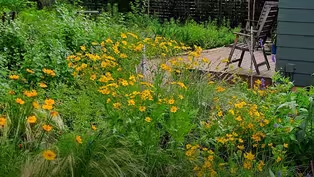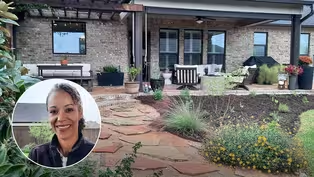
Drought-tough Cottage Design with Native Plants
Clip: Season 29 | 8m 11sVideo has Closed Captions
Alexa Volpe never knew that gardening could be so hard until moving to rocky soil in San Antonio.
Alexa Volpe never realized that gardening could be so hard until she and her family moved to rocky terrain in San Antonio. Bent on turning her routine lawn-and-shrub yard into a fun destination and home to lots of butterflies, bees, and other wildlife, she dug into native and adapted plants.
Problems playing video? | Closed Captioning Feedback
Problems playing video? | Closed Captioning Feedback
Central Texas Gardener is a local public television program presented by Austin PBS
Support for CTG is provided by: Lisa & Desi Rhoden, and Diane Land & Steve Adler. Central Texas Gardener is produced by Austin PBS, KLRU-TV and distributed by NETA.

Drought-tough Cottage Design with Native Plants
Clip: Season 29 | 8m 11sVideo has Closed Captions
Alexa Volpe never realized that gardening could be so hard until she and her family moved to rocky terrain in San Antonio. Bent on turning her routine lawn-and-shrub yard into a fun destination and home to lots of butterflies, bees, and other wildlife, she dug into native and adapted plants.
Problems playing video? | Closed Captioning Feedback
How to Watch Central Texas Gardener
Central Texas Gardener is available to stream on pbs.org and the free PBS App, available on iPhone, Apple TV, Android TV, Android smartphones, Amazon Fire TV, Amazon Fire Tablet, Roku, Samsung Smart TV, and Vizio.
Providing Support for PBS.org
Learn Moreabout PBS online sponsorship(calm music) - I would describe my garden as a xeriscape cottage design.
And I wanted something that was really lush and green and had interest all year, but I also wanted it to be drought tolerant.
Hi, my name is Alexa Volpe.
I'm a gardener here in San Antonio, Texas.
I have been, you know, piddling and putzing out in the garden since I was a little kid in South Florida.
And I remember watching, you know, my family growing herbs and veggies and all kinds of things out in the yard.
My parents are Italian and Italian folks love to, you know, get their hands out there in the earth.
And so I grew up watching a lot of friends and family have their little plots.
Down there, you put something in the ground and it grows.
But here in San Antonio, we have to be able to garden between these extremes, you know, the drought and the heat, and then these cold snaps that we get that can be very taxing on our plants.
Not only did I wanna have a space where we could have a destination and something to do, but I also wanted something that would attract wildlife and pollinators and sort of give a little bit back to some of the habitats that, you know, are missing around in our suburban communities.
When we moved here about five years ago to San Antonio, the yard was just pretty much grass and some of our evergreen shrubs and trees in the back.
And there was really no, there was really no purpose to go outside.
You know, it was hot and maybe the kids played in the yard, but I knew that I wanted to create a destination back there.
Was that a patio or a walkway or something?
And there was so many ideas that I had going on, but you know, in those first years, it was kind of discouraging gardening because all the fancy plants that I bought at the big box stores were dying.
And I was like, "Gardening in central Texas is a whole 'nother thing."
We live on top of the Edwards Aquifer, so our soil is pretty shallow and we have a lot of rock underneath.
We have a mix of builder's clay, so I'll dig in certain spots and it'll be that sort of red clay that looks like it's been added to the area.
Other parts of the yard, I'll dig and you'll hit limestone.
And so I started by using, you know, plant lists that I had found on "Central Texas Gardener", plant lists that I had seen from Garden Style San Antonio and the Grow Green Initiative in Austin.
And so those were excellent resources, I think, for building that vocabulary of what works out in our landscapes.
And so I picked based on color.
I picked based on what's a host plant.
I chose plants that would re-seed so that I knew I'd have volunteers in the coming seasons.
I chose plants that would add texture or structure like different yuccas and cacti.
And in the end, what I have is this, you know, this smorgasbord of color out there.
And as an artist on hiatus, I would say these new plants that I have are my palette.
And so when I go out there and I see all of these colors, it gives me a lot of joy.
And maybe not half, but 30% of the plants out there, I propagated from parking lots and construction sites.
You know, I would drive along the road and I'd be parked in a parking lot somewhere and I'd say, "Well, that little thing is growing in between the cracks.
That must be a really successful Texas plant."
And so I started by, I would say, "Well, you know what, this little Indian blanket flower, I'm just gonna see if I can grab the roots, you know, and put it out in the yard and see if it catches."
And so I started to have a lot of luck and I found that if you soak, you know, a specimen in water for the day before and then plant it, I had really great success with the roots catching.
And that luck translated to getting a lot more excited about the plants that are in my area.
I like to think that so much of my garden really is a souvenir of my traipsing around San Antonio because a lot of the plants that I have out there are maybe little pieces I've cut off from a walk along one of the trails here or something from somebody else's garden.
That was actually a little, like a cutting that I took from a plant on the outside and I left it in water.
I let it form some roots and it was a tiny little shoot when I had it.
And it's grown into this monumental plant.
It's taken two springs for it to look like that, and it attracts bees.
I know in the show sometimes people talk about how certain plants are good for their seeds because a lot of birds will eat them.
And I just never catch the birds out there eating any seeds.
And then the other day, I walk by and I see these two beautiful little finches just perch on the stems of the salvia out there and they're just quick, quick, quick nibbled the seats right out.
And so it felt incredibly gratifying.
Like, what I planned to set out to do is to create a space that I could enjoy, that wildlife could enjoy.
It just was a beautiful culmination of all that work.
And so this year I said, "You know, why don't I add my produce in the middle of all of that that I've got going on?"
And I've always, I guess put in, you know, kales or the Swiss chard.
There's lots of parsley, cilantro, all the dill, you know, those service host plants, but we also get to eat them.
This year I've had this crop of the swallowtail butterfly caterpillars on all my dill.
And I'll tell you, for years I tried to grow, for example, zucchinis and zucchinis have to be fertilized.
You know, they have to be pollinated and I could never get a single flower to set.
And then I said, "Well, probably I don't have a lot of bees, it's just grass out here.
There's nothing for anybody to come out."
And now the yard is just, I mean, I'm taking pictures of every butterfly that's out there and it's not just butterflies, there's little moths and you know, there's all kinds of different bees and different sizes and there's, you know, little flies that pollinate.
So everybody's out there and I noticed that even my veggies that I have in my little garden containers are setting as well.
When I was planting the garden, what we originally had back there was a lot of sod.
Because we live in a lot of hilly area in this part of San Antonio, we already had the terracing, you know, with the increase in the rock there.
I wasn't sure if I wanted to add flagstone or do some sort of rock path, but I said, "You know what, I'm just gonna keep it super simple.
I'm gonna leave a space to walk with just the mulch."
And then as I have cut back tree limbs and stuff has died in the frost, I kind of wanted this sort of woodland aesthetic.
And so I've lined the mulch bed with different tree limbs, you know, put in little succulents sort of along the way.
And so the bed is very organic and natural and when you go out there, you almost feel like you're walking, you know, on a nature trail.
You know, you just lift up the limb and there's all like, you know, little critters underneath it and rollie pollies and all kinds of stuff.
I tried to create little spaces within the walking path and just within the garden that have a little bit of whimsy that get my kids excited about going out there.
I have a little area in which, you know, my daughter and I, we go thrift shopping and she picks out little knickknacks and she calls it her little center, you know, where she puts her favorite little items and she goes out there and she gardens in that space moving things around and putting things to her liking.
And then, you know, my son also has a little section where he likes to sort of put flowers and arrange rocks and then I have bowling balls out there and little plates and things that are just, I pick up along the way.
The first bed that I made I made to honor my grandfather who passed away a few years ago.
And so I said, "You know what, I'd love to really make a garden."
And I have a plaque out there with his name on it.
We walk by and we think about him.
I volunteer on the PTA board at our local school and so I've been active in turning one of the gardens for the kids into one that is a pollinator-friendly garden that uses and showcases the resiliency of our native plants.
I worked on that project and then I decided that I would love to help out even just in our own community.
So I volunteered on our HOA to be able to help them design in some of the more, I guess, complicated spaces of our public or of our community properties.
I'd like to be able to go out there and feel like in a world where it feels so hard to make a difference, you're actually changing the planet just a little bit, even in your own yard.
(bright music)
Contemporary Courtyard Makeover
Video has Closed Captions
Clip: S29 | 9m 29s | In a ground-level makeover, a young couple went for outdoor living and wildlife habitat. (9m 29s)
Blank Yard to Wonder-Filled Gardens
Video has Closed Captions
Clip: S29 | 8m 54s | Richie and Nkiru Gelles applied muscle and imagination to turn their backyard into a lively habitat. (8m 54s)
Garden Design: Plant Communities for Wildlife
Video has Closed Captions
Clip: S29 | 9m 27s | On an old lot, new owners envisioned an urban wildlife sanctuary for year-round beauty. (9m 27s)
Rain Gardens: Catch and Hold Runoff Water
Video has Closed Captions
Clip: S29 | 7m 55s | See how to create a rain garden with beautiful native and adapted plants for pollinators. (7m 55s)
Butterfly Garden Performs at Repertory Theater
Video has Closed Captions
Clip: S29 | 9m 14s | An urban butterfly sanctuary restores life to soil and soul in daily pollinator performances. (9m 14s)
Easy Way to Germinate Texas Mountain Laurel Seeds
Video has Closed Captions
Clip: S29 | 3m 40s | Get the secret to success with Billy Garza. (3m 40s)
Music to Your Ears: Food, Fun, Family
Video has Closed Captions
Clip: S29 | 7m 37s | Musicians and home-schoolers Lisa and Shane Lamb grow their garden goals one weekend at a time. (7m 37s)
Parking Lot to Wildlife Habitat Park: St. John Encampment
Video has Closed Captions
Clip: S29 | 8m 22s | Once crowded with cars, this former mall parking lot now gathers another kind of community (8m 22s)
Grow Soil Health with Mushroom Blocks
Video has Closed Captions
Clip: S29 | 4m 35s | Smash and mulch recycled mushroom blocks for healthy, productive plants. (4m 35s)
Garden Love Germinates at Rental House
Video has Closed Captions
Clip: S29 | 7m 44s | Cyrano Carroll wasn’t keen on digging in until a chance opportunity changed his life. (7m 44s)
Video has Closed Captions
Clip: S29 | 9m 17s | Kat and Dave Sherby fell for a big yard that beckoned creative brainstorming for wildlife watching. (9m 17s)
From Cattle Ranch to Wildlife Paradise
Video has Closed Captions
Clip: S29 | 8m 42s | These days, wildlife graze four acres of native plant gardens on former ranchland in Jarrell. (8m 42s)
Drought-tough Cottage Design with Native Plants
Video has Closed Captions
Clip: S29 | 8m 11s | Alexa Volpe never knew that gardening could be so hard until moving to rocky soil in San Antonio. (8m 11s)
How Biking Led to No Lawn Native Plants
Video has Closed Captions
Clip: S29 | 8m 43s | Biking along country roads inspired Laura O’Toole to rip out lawn for beautiful native plants. (8m 43s)
Celebrating Life on Day of the Dead
Video has Closed Captions
Clip: S29 | 8m 11s | Dia de Los Muertos pays tribute to our lost loved ones who influenced our lives, souls, and culture. (8m 11s)
Small Yard Makeover: From Grass to Wildlife Diversity
Video has Closed Captions
Clip: S29 | 9m 30s | Ecologist and mycologist Chris Garza controlled flooding rain and restored the soil in a small yard. (9m 30s)
Three Stories of Change: Wildflower Pocket Gardens
Video has Closed Captions
Clip: S29 | 9m 23s | Pollinators and birds waltz around native plants where lawn grass once dominated. (9m 23s)
Less Lawn, More Wildlife, Lessons Learned
Video has Closed Captions
Clip: S29 | 9m 23s | Natalie McAnarney’s family spends more time in the backyard since she swapped dull for enchanting. (9m 23s)
Providing Support for PBS.org
Learn Moreabout PBS online sponsorship

- Home and How To

Hit the road in a classic car for a tour through Great Britain with two antiques experts.












Support for PBS provided by:
Central Texas Gardener is a local public television program presented by Austin PBS
Support for CTG is provided by: Lisa & Desi Rhoden, and Diane Land & Steve Adler. Central Texas Gardener is produced by Austin PBS, KLRU-TV and distributed by NETA.
